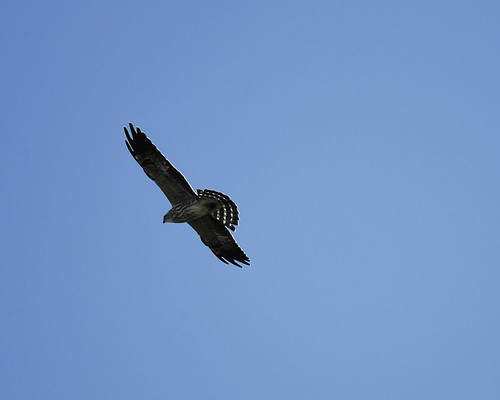tags: Mississippi Kite, Ictinia mississippiensis, birds, mystery bird, bird ID quiz
[Mystery bird] Mississippi Kite, Ictinia mississippiensis, photographed at Smith Point, Texas. [I will identify this bird for you in 48 hours]
Image: Joseph Kennedy, 30 September 2009 [larger view].
Nikon D200, Kowa 883 telescope with TSN-PZ camera eyepiece 1/750s f/8.0 at 1000.0mm iso400.
Please name at least one field mark that supports your identification.


First impressions are it's a Buteo( Buzzard this side of the ocean). Streaked breast, pale underwing coverts and evenly spaced white tail bands suggest Swainson's Hawk.
Hmmm, first thoughts were also from the genus Buteo, something like a Broad-winged Hawk or a light morph of a Red-shouldered Hawk but the body looks too slender and the tail banding much more distinct so decided upon a juvenile Mississippi Kite (Ictinia mississippiensis): heavily brown-streaked underparts (Cornell) and banded tail (Audubon)...
Good call, David. In Texas, the only hawks that should show that tail pattern are adult Red-shouldered, immature or some female Mississippi Kite, and Merlin. The wing shape immediately rules out the first and third.
Hmmm. Aren't the wings too broad and blunt for a Kite? I would expect the wings to be more pointed. Also Ferguson-Lees says "a small falcon-like kite with long pointed wings" which I don't get from this photo. Are the streaks on juv Mississippi only on the breast/belly or do they extend onto the undertail coverts? Is this important?
Adrian, I have read that the Mississippi Kite has a "Popeye" look implying that the "hand" is wider than the "arm" and therefore, as opposed to a Peregrine which has evenly tapered pointed wings and with which it is sometimes confused, looks more robust; also differentiating it from a Peregrine, the tail is characteristically flaired as in the photo above...
Adrian, this bird is in a full soar, and seen from slightly behind. Although most field guides don't illustrate it well, given the angle and flight posture the wing shape is about right for Mississippi Kite -- especially a juvenile. Juvies have longer secondaries than adults, and a broader wing as a result. The apparent lack of points on the wings is a consequence of the feathers being fanned out. (I've just checked all the guides I have, except for Ligouri's, and only Brian Wheeler shows a Kite in full soar.)
Swainson's Hawk does have a long, slender wing for a buteo, although I would expect a bit more bulk. However, assuming there's no molt (and this bird has a very smooth trailing edge to the wing, indicating that it is a juve and therefore shouldn't be molting), a Swainson's should have p8 and p7 as the longest feathers on the wingtip. Kites show p9 and p8, as this bird does.
As far as the streaks below, I can't find any info on how far they go -- if it is important, it appears that no-one has actually bothered to find out.
David, with regards to the flared tail, that shows best when the tail is folded. The flare is caused by the outer feathers being slightly curved to the outside. When in a soar like this, a Peregrine will fan it's tail out, sometimes as far as this bird has. A better point for distinguishing Kites and Peregrines when soaring is the outer primary. In a Peregrine, it's very close in length to the next one in. In a Kite, it's distinctly shorter.
Thanks for the info psweet. I certainly learn a lot about nearctic birds from this site. The reason I asked about the undertail is that all the illustrations I've seen show Mississippi juvs as having streaking or barring there and I wondered if this was always the case.